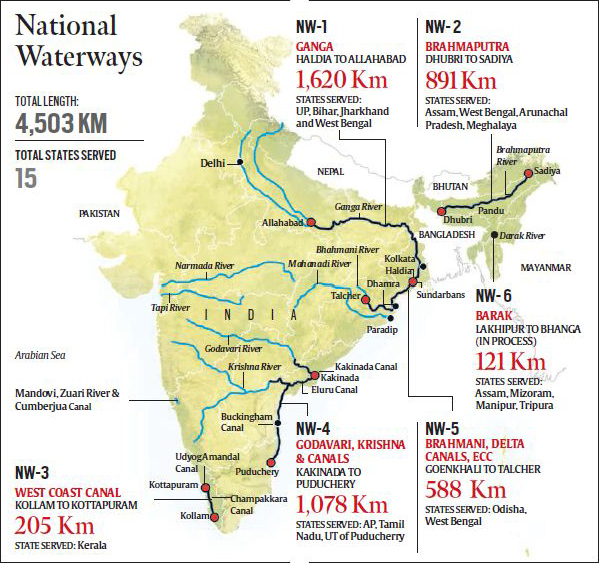Indian Economy
Use of Waterways for Reducing Transportation Cost
- 17 Mar 2020
- 3 min read
Why in News
Recently, the Minister of State for Shipping has informed in the Rajya Sabha that significant savings in the cost of transportation are expected by using the Inland Water Transport (IWT) mode.
- IWT mode is widely recognized as environment-friendly and cost-effective mode of transport.
- It aims to create for the shippers and logistic players, an alternative to the two dominant modes of transport viz. road and rail.
Key Points
- As per RITES Report of 2014 on Integrated National Waterways Transportation Grid, the cost comparison on the modes of surface transport is given below:

- India has about 14,500 km of navigable waterways which comprise of rivers, canals, backwaters, creeks, etc.
- About 55 million tonnes of cargo is being moved annually by IWT, a fuel-efficient and environment-friendly mode.
- As per the National Waterways Act 2016, 111 waterways have been declared as National Waterways (NWs).
- National Waterway-1 (Prayagraj-Haldia) with length 1620 km is the longest National waterway in India.
- The Inland Waterways Authority of India (IWAI) is implementing the Jal Marg Vikas Project (JMVP) at an estimated cost of ₹5369.18 crores for capacity augmentation of navigation on the Haldia-Varanasi stretch of Ganga (part of NW-1) with the technical and financial assistance of the World Bank.
Integrated National Waterways Transportation Grid
- It plans to link many of the national waterways to each other and also to roads, railways and major ports.
- Setting up of a large number of ports/terminals, riverside jetties, godowns, boat building workshops, repairing yards and ancillary industries will spur investment opportunities.
- The capital cost is estimated at ₹22,763 crores to be used in phase-I (2015-18) and phase- II (2018-23).
Inland Waterways Authority of India
- It came into existence on 27th October 1986 for development and regulation of inland waterways for shipping and navigation.
- It primarily undertakes projects for development and maintenance of IWT infrastructure on national waterways through grants received from the Ministry of Shipping.
- It is headquartered at Noida with regional offices at Patna (Bihar), Kolkata (West Bengal), Guwahati (Assam) and Kochi (Kerala) and sub-offices at other places throughout India.







